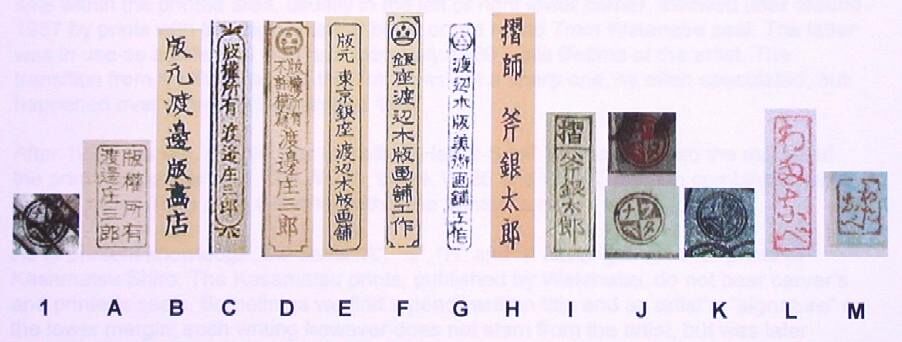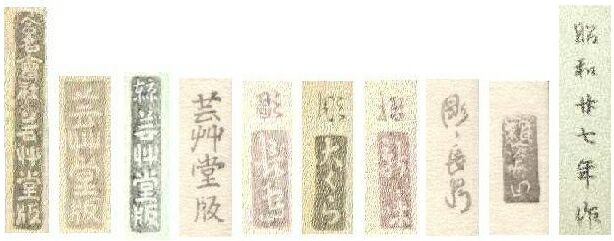
A Short Guide
For both collectors and dealers of woodblock prints, precise dating and the knowledge about the various editions of a print is essential to determine the value of a given print. In the following article, the basic facts as far as available, are summarized for the prints of Shiro Kasamatsu. Since this content is neither perfect nor yet complete, the author appreciates any additions, corrections and new "discoveries."
Watanabe
As for dating, Kasamatsu's prints clearly follow the rules of the Watanabe publishing house. His earliest prints (W-1, W-2-, W-3, W-4, W-5), all published in 1919, carry either a black round 6mm seal or no seal. The blocks of these prints were destroyed in the fire following the 1923 Great Kanto Earthquake; therefore, they never were reprinted after 1923.

|
# |
Period |
Remark |
Applicable for Shiro Kasamatsu
|
|
1 |
1918-1924 |
(6mm), PRE-earthquake version |
Yes |
|
A |
1924-1930 |
"A" seal |
No |
|
B |
1927-1932 |
"B" seal |
No |
|
C |
1929-1942 |
"C" seal (so-called "Sausage Seal") |
Yes |
|
D |
1931-1941 |
"D" seal |
Yes |
|
E |
1932-1942 |
"E" seal |
Yes |
|
F |
1934-1941 |
"F" seal |
Yes |
|
G |
1942-1945 |
"G" seal |
Yes |
|
H/I |
ca. 1943-1947 |
These are not true "publisher's seals," but the seals of the printer (Suri) Ono Gintaro, who was one of Watanabe's long term printers. During the years 1943-1947 his seal was sometimes placed on Hasui prints instead of the usual "publisher seal." |
No |
|
J |
1946-1957 |
"6mm" seal - (actually measures 5.5 to 6.5mm, depending on version); reads "Wa-ta-na-be" in Japanese "katakana." |
Yes |
|
K |
1957-1989 |
"7mm" seal, reads "Wa-ta-na-be" in Japanese "katakana." |
Yes |
|
L
|
1989-present |
So-called "Heisei seal", reads "Wa-ta-na-be" in Japanese "hiragana". Often combined with seal “K.” |
Yes |
|
M |
? |
"Gift seal," reads "Wa-ta-na-be" in Japanese "hiragana." |
Yes |
Prints published in the period 1932 - 1945 bear one of the typical "oblong" Watanabe seals on their margins. Exceptions of this principle are not known. We do not know whether the complete range of seals “D” to “G” got used for Kasamatsu's prints, however, any of his prints of the period 1932 - 1945 with such a seal can be considered a first or very early editions. The most common seal on prints of Shiro Kasamatsu of this era is the Watanabe “C” seal. Kasamatsu prints with the red, so-called “Gift Seal” ("M") are known too, but rare, and their precise dating is difficult, with most probably pre-war or immediately post-war. Sporadically, prints without any seal are also found.
Postwar editions until approximately 1957 show a black (sometimes red) round 6mm Watanabe seal within the printed area, usually in the left or right lower corner. Then, from approximately 1957 onward, prints were then sealed using the slightly larger black (sometimes red) round 7mm Watanabe seal. This latter 7mm seal was in use as the sole seal until approximately 1989 - and are still within the lifetime of the artist. Again, the transition from the 6mm seal to the 7mm was not a sharp one, as often speculated, but happened over a certain time of approximately 1957.
After 1989, the red, rectangular so-called “Heisei-seal” then got applied onto the margins of prints (only prints W-6, W-8, W-10, W-14, W-35 and W-40), often in combination with a black round 7mm seal (this latter seal within the printed area).
As to present knowledge, the seals “A“, “B“, “H“ and “I“ never got used for prints of Kasamatsu Shiro. The Kasamatsu prints, published by Watanabe, do not bear carver's and printer's seals. Sometimes we find a pencil written title and an artist's “signature” on the lower margin; such writing however does not stem from the artist, but was later added by Watanabe's sales staff on prints destined for foreign customers. Many prints, both pre-war and post-war, bear a tiny ink-stamped “Made in Japan” stamp on their verso, or occasionally also in form of a paper sticker. Neither of these stamps or stickers are helpful in the dating of prints. However, a similar, sometimes applied stamp/sticker reading "Made in Occupied Japan" is more helpful, it was in use from just after the War until approximately 1952.
Kinjiro
Our knowledge about the publisher Kinjiro is very limited. Prints published by Kinjiro do not bear any seal, we therefore lack information about their dating and editions. Condition of the prints and paper however indicate that apparently only early editions exist.
Unsodo Publisher (since 1887)
Kasamatsu's prints published by Unsodo show in their left margin (a very few prints on their right margin) typically three seals - publisher, printer and carver. Additionally, according to Unsodo, only the first edition of 100 (occasionally to 250) prints of a given Kasamatsu print bears in the lowest position of this same left margin the Japanese style DATE written in Japanese "kanji" characters--just below the typical publisher, carver and printer seals. In principle therefore, all later editions which do not carry such "margin-dating" information thusly allow a reliable differentiation. The author knows of only one print where a subsequent early edition still bears the date block--the "Kegon Falls" print (#U-3), which is known as a first edition with two different publishers seals “A” and “B”.
|
|
Both early and later editions bear--a few exceptions (e.g., print "Inokashira" #U-22) are known--the “Gei” watermark in one corner of the paper. The "Gei" kanji is the first character of the name Unsodo. "Portrait" format prints have the waternmark in the lower left corner of the paper, in "landscape" format prints the watermarks migrates into the left upper corner. |
The printer's seal unfortunately is of little aid to the dating of Kasamatsu prints, because Unsodo's contract printer, Shinmi Saburo (whose name also allows the pronunciation Niimi Saburo) printed virtually all Kasamatsu prints, from the "first editions" in the 1950's until about 1996. Even the most recent strikes printed after 1996 still may carry the Shinmi seal. Only very recently, since about 1999, has the seal of the new printer Toda Tadashi gotten used, printed together with "new designs" of the publisher and carver seals.
Unsodo and Kasamatsu - The Seals Timeline

A B C D E F G H I J
| Further seals of Unsodo are known, but not for prints by Shiro Kasamatsu. The years and periods mentioned in the following apply solely for the prints of Shiro Kasamatsu. For different artists (e.g., Takeji Asano) some of the above shown seals were already used prior to the dates below.
|
|
# |
Period |
Remark |
A |
1952 - 1953 |
"Gomei Gaisha Unsodo Han" (Unsodo Publisher, Ltd.). Unsodo changed Showa 28 (1953) the legal entity from “Gomei Gaisha” into “Kabushiki Kaisha” and hence adapted the seal. |
B |
1953 - now |
"Unsodo Han", most common Publisher Seal of Unsodo |
C |
1957 -? |
"Tokyo Unsodo Han", used by Unsodo's Tokyo Branch |
D |
1999 - now |
"Unsodo Han", new seal |
E |
1952 - now |
Carver Seal (Hori) Nagashima (Michio) |
F |
1957 - now |
Carver Seal (Hori) Okura (Hanbei) |
|
G |
1952 - now |
Printer Seal (Suri) Shinmi (Saburo) |
|
H |
1999 - now |
Carver Seal (Hori) Nagashima (Michio), recent version |
|
I |
1999 - now |
Printer Seal (Suri) Toda (Tadashi) |
|
J |
1952 - 1960 |
Typical date, Japanese style, only used for "first editions" |
The predominant seal combination is B-E-G, followed by B-F-G. Other combinations are known, but rare. Publisher, carver and printer seal combinations together with a date like “J” are "first editions" (in Japanese “jozuri”) and without such date are later editions (“atozuri”). One print, "Senzoji Temple, Asakusa" (#U-30), as an exception, is known without carrying the carver seal.
The combination D-H-I - never in conjunction with a date “J” - is in use only since approximately 1999 for posthumous editions, but as it seems, not consistently for all reprints. The differentiation between late editions, struck during the lifetime of the artist, and posthumous editions if the latter bear seals other than the new D-H-I combination and hence cover a period of up to 40 years, is very difficult and therefore calls upon a skilled knowledge of condition of the paper and quality of the printing.
Self-Published Prints
Shiro Kasamatsu's self-carved, self-printed and self-published prints commonly bear pencil written numbers in the lower right or left corner outside the printed area, which tell the edition size and number of the individual print. Sometimes the artist changed the position of the marking between the left and the right corner within one and the same edition.
The edition sizes vary between 50, 100, 200, 250 and 300 prints per edition, with 100 and 200 being the most typical and common sizes of an edition. Although “odd” size editions (see example below) are known as well.
If reprinted, subsequent later editions got marked in addition with a capitalized “B”, “C”, “D” etc., indicating a second, third or fourth edition. Often, as a matter of demand, a later edition was of a smaller size than the first edition of the same print. In a few cases, prints reached the art market without any edition information. Most of the self-published prints carry on their margin the red, rectangle seal “Shiro Hanga” (meaning "Shiro prints"). Different editions of a print may carry different artist's seals, also the brush signature can be in a different space of the print.

|
First Edition 57/100 |
First Edition 4/200 |
First Edition 277/300 |
Second Edition 14/26 |
Fourth Edition 38/100 |
Watermarks
Some of the self published prints carry a watermark in their lower left corner.
|
|
The watermark reads "Shi", a part of Shiro's name (which also has the meaning "murazaki," purple). |
Other Prints
Kasamatsu's prints other than those of the oban format usually do not show dates, seals or handwritten information. Until we possess better information, any dating has to rely solely on the condition of print and paper.